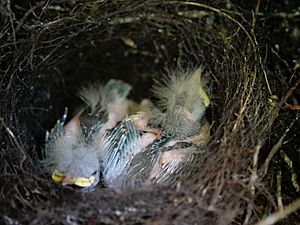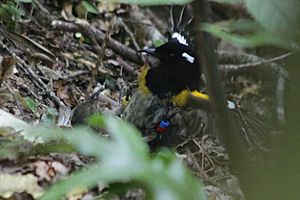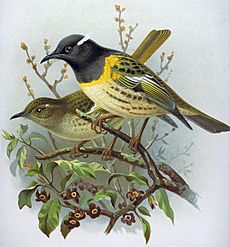Stitchbird facts for kids
Quick facts for kids Stitchbird |
|
|---|---|
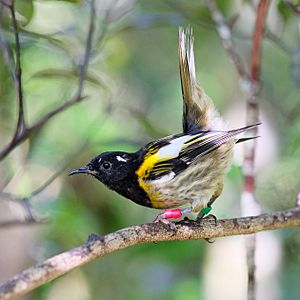 |
|
| Male in typical 'tail cocked' stance | |
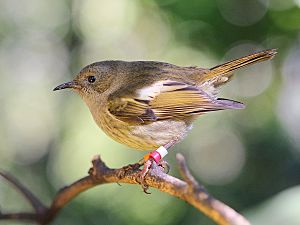 |
|
| Female | |
| Conservation status | |
| Scientific classification | |
| Genus: |
Notiomystis
|
| Species: |
cincta
|
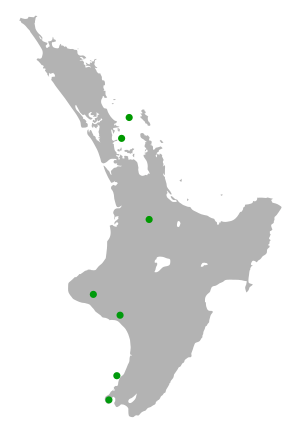 |
|
| Islands and sanctuaries where stitchbirds are present | |
The stitchbird or hihi (Notiomystis cincta) is a special bird found only in New Zealand. It looks a bit like a honeyeater bird. You can find it on the North Island and some smaller islands nearby.
For a long time, scientists weren't sure how the stitchbird was related to other birds. But now, they know it's the only member of its very own bird family, called the Notiomystidae.
Sadly, the stitchbird became very rare. It disappeared from almost everywhere except Little Barrier Island. But thanks to conservation efforts, it has been brought back to other safe island homes and even a few places on the North Island.
Contents
What is a Stitchbird?
The stitchbird was first thought to be part of the honeyeater family, which mostly lives in Australia and New Guinea. It stayed in that group for many years.
However, recent genetic tests showed that the stitchbird is not closely related to honeyeaters at all. Instead, its closest living relatives are other unique New Zealand birds called Callaeidae.
Because of this, in 2007, scientists created a brand new bird family just for the stitchbird. This family is called the Notiomystidae.
How to Identify a Stitchbird
The stitchbird is a small bird that looks a bit like a honeyeater.
Male Stitchbird Appearance
Male stitchbirds are quite striking. They have a dark, soft-looking cap on their head. They also have short, white ear-tufts that they can raise up.
A bright yellow band crosses their chest, separating their black head from their grey body.
Female and Young Stitchbirds
Female stitchbirds and young birds are not as colorful as the males. They don't have the black head or the bright yellow chest band.
Stitchbird Beak and Tongue
Their beak is thin and slightly curved. They have a long tongue with a brush-like tip. This special tongue helps them collect nectar from flowers.
You might also notice thin whiskers sticking out from the base of their beak.
Stitchbird Calls and Sounds
Stitchbirds are very active and make a lot of noise. Their most common sound is a "tzit tzit." People think this sound is how they got their name, "stitchbird."
They also have a high-pitched whistle. When they are alarmed, they make a nasal "pek" sound, similar to a New Zealand bellbird. Male stitchbirds often make a loud, three-note whistle, especially in spring. They have other calls that females don't make.
Stitchbird Behavior and Diet
Stitchbirds are known to compete for food with other birds like the tui and New Zealand bellbird. If these larger birds are around, stitchbirds might have to eat from less preferred food sources.
Stitchbirds rarely land on the ground. They also don't often visit flowers on large trees, which are popular with tui and bellbirds. This might be because the bigger, more aggressive birds chase them away.
What Do Stitchbirds Eat?
Their main food is nectar from flowers. Stitchbirds eat nectar from over twenty types of native flowers and thirty types of fruit. They also eat from many introduced plants.
Some important native nectar sources include haekaro, matata, puriri, rata, and toropapa.
They enjoy fruits from Coprosma species, five finger, pate, tree fuchsia, and raukawa.
Stitchbirds also eat small insects to add to their diet.
Stitchbird Reproduction
Stitchbirds build their nests inside holes high up in old trees. They are the only bird species known to mate face-to-face.
Interestingly, many of the chicks in a stitchbird nest might have different fathers. This is quite common for this bird species.
Stitchbird Conservation Efforts
Stitchbirds were quite common when Europeans first arrived in New Zealand. But their numbers quickly dropped after that. By 1885, they had disappeared from the mainland and many offshore islands. The last time a stitchbird was seen on the mainland was in the Tararua Range in the 1880s.
We don't know the exact reason for their decline. However, scientists believe it was due to new animals brought to New Zealand, like black rats. New bird diseases might have also played a role.
Only a small group of stitchbirds survived on Little Barrier Island.
Bringing Stitchbirds Back
In the 1980s, the New Zealand Wildlife Service (now the Department of Conservation) started moving stitchbirds from Little Barrier Island to other safe island homes. This was done to create new populations.
These islands are part of New Zealand's special network of reserves. They have been cleared of introduced animals and protect other rare species, like the kakapo and takahe.
Current Population and Challenges
The total number of stitchbirds in the world is not fully known. Estimates for the population on Hauturu (Little Barrier Island) range from 600 to 6000 adult birds.
There are also new populations on Tiritiri Matangi Island, Kapiti Island, Zealandia, Maungatautari, Bushy Park, and Lake Rotokare.
Some attempts to create new populations on other islands, like Hen Island, Cuvier Island, and Mokoia Island, and in the Waitākere Ranges, were not successful.
When new populations are started from a small number of birds, it can lead to less genetic diversity. This means the birds are more closely related, which can cause problems like inbreeding.
The population on Tiritiri Matangi Island is one of the most successful. It has grown quickly and now has about 150 birds. However, about 30% of their eggs don't hatch because of inbreeding.
Only the Little Barrier Island population (Te Hauturu-o-Toi) is strong enough to survive without human help. Because the stitchbird lives in such a small area and has few populations, the IUCN lists it as Vulnerable.
Successful Reintroductions
In 2005, 60 stitchbirds were released into Zealandia (wildlife sanctuary) near Wellington. In October of that year, three stitchbird chicks hatched there. This was the first time in over 120 years that a stitchbird chick was born in a protected area on the mainland.
Sanctuary staff called these hatchings a very important step for conservation. By early 2019, Zealandia had banded their 1000th hihi chick, even though the adult population stays around 100 birds.
In 2007, 59 adult birds from the Tiritiri Matangi population were released in Cascade Kauri Park, near Auckland. By the end of that year, the first chicks had left their nests there.
In 2017, 40 stitchbirds were released into the Lake Rotokare Scenic Reserve in Taranaki. They successfully raised 17 chicks. Another 30 birds were released there in 2018.
See also
 In Spanish: Hihi para niños
In Spanish: Hihi para niños





